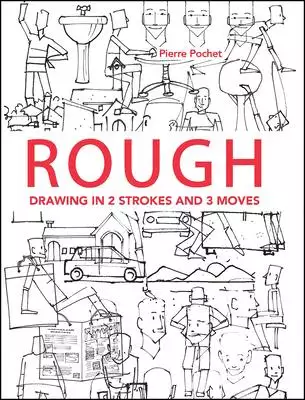Facial expression da的問題,透過圖書和論文來找解法和答案更準確安心。 我們找到下列問答集和資訊懶人包
Facial expression da的問題,我們搜遍了碩博士論文和台灣出版的書籍,推薦寫的 Rough: Drawing in 2 Strokes and 3 Moves 和的 Techniques for Assessment of Parkinsonism for Diagnosis and Rehabilitation都 可以從中找到所需的評價。
這兩本書分別來自 和所出版 。
國立陽明交通大學 藥理學研究所 嚴錦城所指導 劉姿婷的 迷走神經刺激抑制皮質傳播性抑制之機制探討 (2021),提出Facial expression da關鍵因素是什麼,來自於迷走神經刺激、皮質傳播性抑制、偏頭痛。
而第二篇論文國立陽明交通大學 神經科學研究所 鄭雅薇所指導 林莉庭的 單胺氧化酶 A 基因多態性的功能性神經影像統合分析 (2021),提出因為有 單胺氧化酶 A 基因、高基因及低基因表現型、統合分析-大腦強的活化反應、高階認知功能的差異、負向情緒及社會痛苦處理的差異的重點而找出了 Facial expression da的解答。
Rough: Drawing in 2 Strokes and 3 Moves

為了解決Facial expression da 的問題,作者 這樣論述:
Do you know how to draw a square, triangle, and rectangle? Well, then, you know how to draw!Rough: Drawing in 2 Strokes and 3 Moves provides you with a way to start drawing that is based on a very simple observation: the human body, as well as everything surrounding us, can be broken down into el
ementary and basic geometric shapes.The technique that author and teacher Pierre Pochet shows you here has no fine art or academic ambitions. Instead, it shows you how to quickly draw from memory a facial expression or a bodily movement, to flesh out a picture, to create a perspective, or to sketch
a scene.This approach to drawing is particularly useful for those who have no artistic training but who are considering a career in a creative field, whether that be advertising, design, or graphics . . . as well as for anyone who simply wants to learn how to draw!
迷走神經刺激抑制皮質傳播性抑制之機制探討
為了解決Facial expression da 的問題,作者劉姿婷 這樣論述:
Abstract in English iAbstract in Chinese iiContent iiiList of Figures viAbbreviations viii1.1 The relevance of cortical spreading depression to migraine 21.2 Vagus nerve stimulation as a promising treatment of migraine 31.3 The role of nucleus tractus solitarii in the
effect of vagus nerve stimulation 41.4 The role of locus coeruleus and dorsal raphe nucleus in the effects of vagus nerve stimulation 61.5 Connection between nucleus tractus solitarii, locus coeruleus, dorsal raphe nucleus, and cerebral cortex 7Chapter 2. Aim 82.1 Rationale 9
2.2 Hypothesis 92.3 Specific aims 9Chapter 3. Materials and Methods 113.1 Ethics 123.2 Animals 123.3 General surgery 123.4 Noninvasive vagus nerve stimulation 123.5 Electrophysiological recording 133.6 Microinjection test agents into nucleus tractus so
litarii and locus coeruleus 133.7 Drug preparation 143.8 Western blot 143.9 Immunofluorescence staining 153.10 Statistical analysis 17Chapter 4. Results 184.1 nVNS exhibited a quasi-dose effect on CSD suppression. 194.2 nVNS inhibited CSD-triggered cortical neu
roinflammation. 204.3 nVNS inhibited CSD-triggered trigeminovascular system activation. 224.4 VNS inhibited CSD via glutamatergic neurotransmission projecting to the NTS 224.5 VNS inhibited CSD and CSD-induced cortical neuroinflammation via TrkB-dependent mechanism in the NTS. 2
34.6 VNS-induced TrkB activation in the NTS is mediated by glutamate receptor 244.7 VNS activated NTS-LC/DRN axis 24Chapter 5. Discussion 265.1 The relevance of nVNS parameters to its clinical efficacy and CSD susceptibility 275.2 The effects of VNS on CSD-triggered neuroinflammation
285.3 The effects of VNS on CSD-triggered trigeminovascular activation 295.3 VNS inhibited CSD exclusively through central mechanisms: the role of NTS-LC/DRN axis 305.5 The role of BDNF-TrkB signaling pathway in VNS efficacy and migraine 305.6 Study limitations 31Chapter 6. Conclusion
34Reference 36Figures 50Tables 93Appendixes 95
Techniques for Assessment of Parkinsonism for Diagnosis and Rehabilitation

為了解決Facial expression da 的問題,作者 這樣論述:
1. Parkinson’s Disease.- 2. Measuring Parkinson’s Disease symptoms.- 3. Demographics profiles of Parkinson’s Disease.- 4.Tremors and Bradykinesia.- 5. Handwriting of Parkinson’s Disease.- 6. Gait and Posture.- 7. Olfactory.- 8. Eye Gaze and Facial expression.- 9. Voice symptoms.- 10. Treatment of Pa
rkinson’s Disease.- 11. Misdiagnosis of Parkinson’s Disease.- 12. Modelling of Basal Ganglia of Parkinson’s Disease. Sridhar P. Arjunan is currently a Research Assistant Professor at the Center for Human Movement Research and Analysis, Department of Electronics and Instrumentation Engineering, SRM
Institute of Science and Technology, India. He received his Ph.D. degree in Electronics and Biomedical Engineering from RMIT University, Australia, in 2009, and was a Postdoctoral Research Fellow at Biosignals Lab at RMIT University. Dr. Arjunan is a recipient of a SPARC-MHRD Project (2019-21), SER
B (2018-21), CASS Australian Early Career Researcher grant (2010), RMIT SECE Research Scholarship (2006-2008) and German State Research Scholarship (2006) and he has published over 100 research articles in various journals and conferences. His major research interests include biomedical signal proce
ssing, rehabilitation studies, fractal theory, human movement and human-computer interface applications. Dinesh Kant Kumar holds a B.Tech. from IIT Madras and Ph.D. from IIT Delhi, and is currently a Professor at RMIT University, Melbourne, Australia. He has published over 400 papers, authored 5 boo
ks and is on a range of Australian and international biomedical engineering committees. His passion is for affordable diagnostics and making a difference for his students. His work has been cited over 5600 times, and he has also had multiple successes with technology translation.
單胺氧化酶 A 基因多態性的功能性神經影像統合分析
為了解決Facial expression da 的問題,作者林莉庭 這樣論述:
單胺氧化酶 A 基因(Monoamine oxidase A gene) 被認為會影響生理機能及行為表現。為了解 MAOA 基因對於人類的潛在影響,過去已有學者透過非侵入式的儀器(像是腦電波、腦造影等方式)來了解基因對於人類大腦活動的變化。此篇研究將透過功能性腦造影(fMRI, PET, EEG neuroimaging 等)統合分析-coordinate meta-analysis(整合過去功能性腦造影活化結果)的方式釐清 MAOA 基因多態性(MAOA variable number tandem repeat/MAOA-VNTR 兩個基因型的大腦強活化反應及比較基因型的強活化反應(相似
、相異處)來推測不同 MAOA 基因表現型(MAOA variable number tandem repeat/ MAOA-VNTR; 可變數目串聯重複多態性:可分為兩種基因表現型- 高和低)對於行為的可能影響。在執行統合分析前,選擇預納入分析的文獻是一個很重要且須嚴謹的流程(依據 Prisma guideline 的指示)。文獻的來源有以下三個主要的資料庫,包含 Pubmed, Medline online (Ovid)和 Web of Science (WoS),另外部分文獻來源為預納入文獻的依據(reference), google scholar 的中文資料庫以及 google 搜尋
引擎,而搜尋的方式為輸入一致的關鍵字: (MAOA OR "Monoamine oxidase A" OR "warrior gene" OR "MAOA-VNTR"OR "MAOA genotype") AND (fMRI OR "functional magnetic resonance imaging" OR PET OR "Positron emission tomography" OR neuroimaging)。最後總共得到 17 篇(10 篇/10 個實驗為高基因表現型;10 篇/12 個實驗為低基因表現型)納入統合分析。在分析後Jackknife Sensitivity ana
lysis 檢測研究結果是否具有可重複性、I2 value 去了解所納入之文章是否具有異質性(Heterogeneity)及使用具客觀性特質的Egger’s test 去了解納入之文獻是否有出版偏誤(Publication bias)。此外,也使用了查看腦造影影像的軟體- MRIcron 中的「重疊」功能,去了解兩者基因型強活化的相似、差異之處。研究結果顯示,兩個基因型背後的大腦活化反應較強的神經網絡和過去研究認為一致,高基因型的人確實在抑制控制、注意力控制、工作記憶相關的腦區有較高的活化量,低基因型的人也在臉部情緒處理相關腦區有較高的活化量。另外,根據兩個基因型各自較高活化量的腦區及過去研究
的討論,我們推測了基因-大腦-行為之間的可能關聯性。本篇研究認為高基因型的人受到高階認知功能(額葉、頂葉)的影響使得他們相對不容易有暴力行為、特質;低基因表現型的人則可能受到負向情緒、社會痛苦處理(額葉、顳葉及皮質下腦區)的影響使他們較容易有暴力行為、特質。